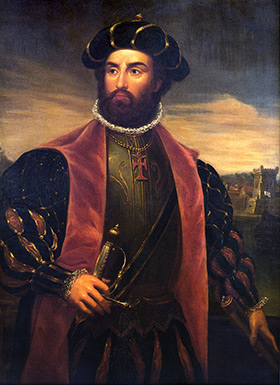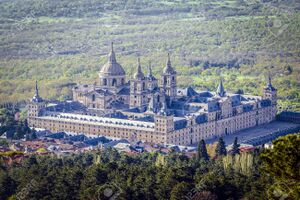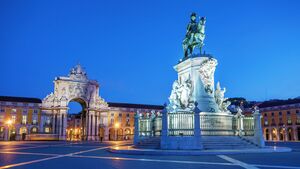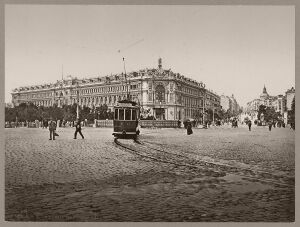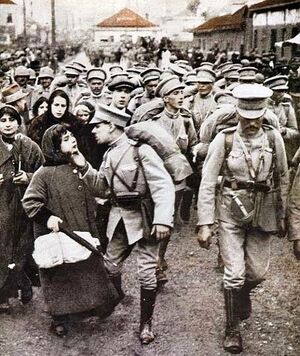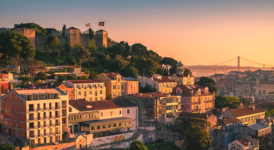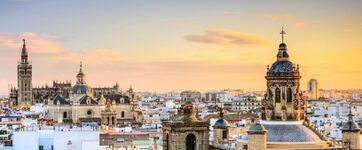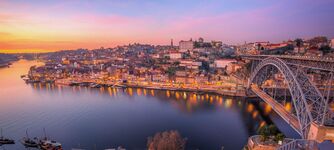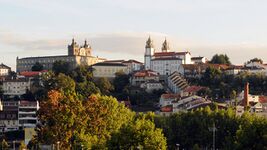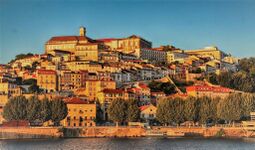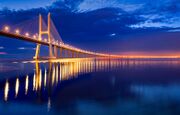Produzland
This article is incomplete because it is pending further input from participants, or it is a work-in-progress by one author. Please comment on this article's talk page to share your input, comments and questions. Note: To contribute to this article, you may need to seek help from the author(s) of this page. |
Kingdom of Produzland [a] O Reino de Proádusia | |
|---|---|
Motto: "Nos Sustinere." | |
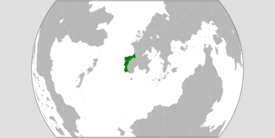 Official map of the Kingdom of Produzland | |
| Capital | Burlon |
| Largest city | Burlon |
| Official languages | Produese |
| Recognised regional languages | Produese, Cabecan, Aenian, Cadasan |
| Ethnic groups (2011) | Produes 90.58% Cabecans 3.63% Others 6.79% |
| Demonym(s) | Produes, Produese |
| Government | Parliamentary Constitutional Monarchy |
| Riccardo Bonadeo, PdP | |
| Legislature | Tribunais Gerais |
| Senate | |
| Congress of Deputies | |
| Kingdom | |
• West and East Aenicia Split | May 29th, 887 |
• Cavale and Galicia Split | March 4th, 987 |
• Establishment of the Kingdom of Cavale and Galicia | February 19th, 1140 |
• De Facto Establishment of the 2nd Kingdom of Produzland | June 20th, 1308 |
• De Jure Establishment of the 2nd Kingdom of Produzland | January 15th, 1715 |
• Established of the Federal Republic of Produzland | July 16th, 1935 |
• Establishment of the 4th Kingdom of Produzland | February 18th, 1980 |
| Population | |
• 2019 estimate | 61,432,763 (20) |
• 2019 census | 61,432,763 |
| GDP (nominal) | estimate |
• Total | 627,875,000,000 |
• Per capita | 10,220 |
| Gini (2011) | 34.67 medium |
| HDI (2011) | 0.781 high |
| Currency | Rozar (ROZ) |
| Date format | mmddyyyy |
| Driving side | right |
| Calling code | +55 |
| Internet TLD | .prd |
Produzland, officially, the Kingdom of Produzland (Produese: O Reino de Proádusia), is a sovereign state in Greater Olympus. Produzland is located on the western half of the Orthurian Peninsula in Southwest Lira. Produzland borders the Aurum Ocean in the west, and Meronnia in the North-East, as well as Parthonopia in the east. The Kingdom covers an area of XXXX square kilometers with an oceanic and mediterranean climate. It is a parliamentary constitutional monarchy with 38 million inhabitants (2014) and King Joseph III as king since 2019.
Around 455 a group of people known as Aenians invaded the Orthurian Peninsula, the Aenians were called the "Produese" as they mixed with the local Orthurians of the the Orthurian province of Produsia. After the fall of the Orthurian Empire, the most notable nations to arise were Aenícia and Calmatia. West Aenícia split from Aenícia to become Cavale a few centuries later. After the division of Calmatia over the course of the middle ages Cavale conquered most of Western Orthuria and became the successor state to Produsia. After a history of imperialism and many royal dynasties, the empire fell apart over the course of the late 1800s and early 1900s. This resulted in a dictator seizing control of Produzland in 1935. The dictatorship was removed in 1980 with the monarchy being restored and Produzland in the modern day being a leading nation in Liran politics.
Produzland is ones of the leading countries in seafood production and luxury items with companies like Calmatia and Ludovico, Venâncio, Gárcere, Rego-Dalgarno Hotel Company, and Vítor Loureiro. Manufacturing is the dominant force in the country with significant contributions from refining. The parts made in Produzland are both exported and made into finished products, though the economic goal of the nation is to export the majority of parts out of the country, while keeping/importing some parts for local manufacturing before exportation. Imports include raw materials as well as finished goods and services from other countries. The resources on hand and the priorities of Produzland influence what type of refinement and manufacturing will take place. Produzland's manufacturing specialties include Train Engines, Train cars, and electrical equipment.
Etymology
The Orthurian Empire named their westernmost province Produsia, meaning "Land of Carrots", which would evolve into Produzland in Lorian. The state that is now Produzland was originally called The Kingdom of Cavale & Galicia until the de facto Kingdom of Produzland began with King Henry I being placed on the Cavallian and Aenician throne. This became de jure in 1715 with the West Bresbon Decrees.
The standard way to refer to a citizen of Produzland is as a "Produe."
History
Early History (-490)
There is little written record of the first civilizations in modern Produzland, however archaeological evidence marks the oldest traces of human life in the region around 1.3 million years ago, living hunter-gatherer lifestyles, and making use of the main rivers of the country in the As Vega and Galicia. The region was the agricultural heartland of Orthuria until the region was brought under the rule of the Orthurian Empire. They named the province Produsia, after the abundance of carrots in the region. Produsia became an integral part of the empire until the Aenian people of northern origin were migrating throughout northwest Orthuria, they set up multiple kingdoms in the north under Aenian control, the most prominent ones at the time being Galicia, Aenicia, Sundrescia, and Cabecia.
Aenicia and Calmatia (490-879)
Under the rule of the Orthurians two main people groups rose to prominence in the west, the Aenians and Calmatians. With the fall of the Orthurian Empire over the course of the 5th century, the two people groups had set up their respective domains. Unlike the Aenians mentioned earlier, the Calmatians formed a unified state in the south comprising territory even north of the Mazarico River, where they took the great city of Olivrium from the Orthurians. During the 6th, 7th, and 8th centuries the Aenians had unified under one country, the Kingdom of Aenicia, while the Kingdom of Calmatia fractured into multiple states including the Kingdom of the Rodaves, the Kingdom of Selcear, and the Kingdom of Cadascun, however at the time the three kingdoms all spoke Cadasan, now known as Southern Produese.
West Aenicia (879-987)
Due to a succession crisis in Aenicia in 879, a country that had become the dominant Aenian country of Orthuria, the country was divided into West Aenicia and East Aenicia, the former being ruled by the bastard son of King Alfonso II of Aenicia, Ferdinand and the Galician House of Fonseca, and the latter ruled by Alfonso's legitimate son Vicente and the already Aenician ruling House of Outeiro. West Aenicia and East Aenicia both held large chunks of territory from Aenian expansion southward since the beginning of the middle ages, East Aenicia held the old united capital of Relâpago, while West Aenicia originally made Arencia the capital of the new country.
Second Split of Crown (997-1140)
The crown of West Aenicia split in 997 after the death of Ramiro II of West Aenicia, he split the country into north and south, the north known as the Kingdom of Galicia, a historical name for the region, ruled by his brother Alfonso III, the south took the name "O Reino de Cavela", or the Kingdom of Cavale ruled by Ramiro II's cousin Ferdinand III.
The Kingdom of Cavale and Galicia (1140-1308)
The crowns of Cavale and Galicia unified again under King Peter I of Cavale and Galicia. This nation state would become the leader of Produese unification and the predecessor state of Produzland. During this period the country is often referred to as simply Cavale. This became an era for advancement for the region, Cavale was cemented as the dominant Produese state. However it yet to expand southward, Vincent II set his eyes on the historic Orthurian city of Luville, which had been in Cadasan hands for centuries. King Vincent personally led an army to the walls of Luville. Luville had always been poorly held by the Cadasans for the last few centuries as their northernmost territory, however Cavallian monarchs had never seized the opportunity. Vincent II led an army directly to Luville while another fought their way to the banks of the Mazarico to cut off Cadasan reinforcements from the city. The city was captured and prestige grew for the united kingdom.
Produese Wars of Unification (1267-1308)
In 1267, tensions were high and lingering from the recent Battle of Luville between the neighboring countries of the Kingdom of Cavale and Galicia and the Kingdom of Cadascun that recently took over the County of Cojazeira from the Rodavese, which would eventually finally be set off when Cadasan king Alfonso VI died in battle against the Selcenese in the Battle of Mergulhe-O-Grande. Cadascun was terribly unprepared to replace the king with 3 month old Prince Henrique of Calmatia, which gave Cavale the perfect chance to take over Anavede and all the south bay area, currently under Cadasan rule, and perhaps even all of the Kingdom of Cadascun. So in the summer of 1267, the Cavallian forces crossed the Mazarico River into Cadascun. Already dealing with internal issues, Cadascun was easily defeated and swept aside at Anavede, Gretia Novo, and Azevedo, until King Vicente II himself and his army arrived at the walls of Cadascun capital, Portuaria. Realizing the city and it's people could be eliminated, the Cadasans surrendered. Cavale firmly incorporated Cadascun into it's territory, which would soon bring it into conflict with the Rodavese and the Selcenese.
In the 13th century the Kingdom of Velarre and the Aenician Duchy of Sundrescia had been in fierce competition over Cabeca. Velarre forming out of the Kingdom of Lurrak in the 1100s. While Sundrescian was Aenian as opposed to Cabecan like Velarre, they still vied for power in the region ever capturing the city of Lurrak itself, renaming it to San Aurelio after the Saint Aurelius.
Due to Gabriel V of Aenicia being incapable of ruling, the Cavallians took the opportunity to press their claim to eastern Galicia, which spiralled into the War of the Thymes in 1301, the war soon turned into a war of succession when the Cavallian king was killed in battle, which with the help of Philip III the Vain and the Sundrescians put Henry I, Count of Lugo on the throne of Aenicia and Cavale in 1308, leaving the two as independent kingdoms under one monarch. At this point they were practically united however. This began the de facto Kingdom of Produzland. The realm had several problems that would plague it for the coming decades, however after time the people of the country would come together and a string of competent monarchs would come to create one of the most powerful nations and empires in history.
Early Produese Empire (1486-1550)
In 1486 Ferdinand VIII took the Produese throne from his father, which historians claim as the beginning of the Produese Golden Age, the Parthonopian Renaissance was prevalent in the country with artists like Osório Da Rosario, Luca Melo, and Balduíno Hernandes. Ferdinand VIII is regarded as the founder of the Produese Empire, over the course of the 16th and 17th centuries, the Produese Empire expanded it's influence heavily in Nori and it's southeastern islands. The first example in 1513 Aloisian explorer Aleixandre do Orestes became the first Liran to land on mainland Nori, despite failing to colonize mainland Nori, this opened up the gateway for Produzland to become the dominant Liran power in east Nori. 20 years later in 1533 Aleixandre do Orestes and company landed on the Strait of Marque island of Comona, establishing São Diego. Years later another company landed on the mainland and established the colonies of Novo Aenicia and Senãles Alto e Baixo in modern Carelia. The trade of the empire made the monarchy immensely wealthy and the gold of the southeast flowed back to Burlon.
The ruling Lugo dynasty also had ambition on the continent, allying with the neighboring nations of Parthonopia, Meronnia, and Velarre to halt Lunderfrausian advances southward, Produzland supplied troops to the famous Siege of Lepanto, a victory for the southern powers. During the war, Ferdinand VIII seized several islands north of the Lunderfrausian coast, using Ferdinand's claim to the islands through his wife as a casus belli. King Ferdinand also continued Produzland's policy of expanding southward deeper into the As Vega, the southern As Vega became a favorite location for Ferdinand VIII, converting the Selcenese Ciduarte Palace in Granarón into renaissance style, and it became one of Ferdinand VIIIs top homes of his court over the course of his reign.
When Ferdinand VIII passed in 1521, he left Produzland in the best position in Lira, however tragedy struck when his son King Henry III, was murdered in a jousting accident in 1539, this lead way however to second son Joseph the Colonizer to revamp the Produese Empire in east Nori with the Produese Gulf Company to promote Produzland to the richest nation in Lira, and the House of Lugo one of the richest in the world.
Joseph's first major feat in his reign being in 1543 when Jorge Adão da Coutinho landed in southern Kiteahu and established Fort Santa Ângela on an island he called Cavaco. Da Coutinho also landed in the eastern islands of modern Jashnagar a few years later, which he and his fleet gave it the name 'Jaixnágar'.
In 1546 the wealthy Republic of the Rodaves began to collapse with wars with Parthonopia and King Joseph took the opportunity to seize the republic. Produzland already held the County of Cojazeira, having been in personal union for a few decades which had sparked tension with the Rodaves, but the Rodaves couldn't afford to go to war with Produzland with their colonial bids draining the republic's treasury. King Joseph personally lead a sacking of the city of Cartaganca. After the fall of the Rodavese capital, the Rodavese forces across the country began to collapse and the Rodaves was annexed. Rebellion and sparse guerilla fighting in the former republic would continue until the Rodavese Revolution of 1643.
Vincennine Produzland (1550-1700)
Tensions with Meronnia were present over the last few decades, mainly as colonial rivals in south-east Nori and Cabeca, which recently was a source for tension as the Kingdom of Velarre became a vassal of Meronnia. The Lugos decided to set up several agreements with their northern neighbor including several arranged marriages and giving Produzland influence in Nori and Meronnia in Meridiq. After Joseph I passed in 1550, he was replaced with his son Philip, and through his mother Philip also inherited the Kingdom of Meronnia in 1551 leaving him as King Philip I & IV of Produzland and Meronnia and he one of the most powerful men in history as Produzland continued their colonial reign in east Nori.
In 1582 when King Philip died, he split his empire in two with his son Vincent III inheriting Produzland and his daughter Ermelina I inheriting Meronnia and beginning the Meronnian branch of the House of Lugo. The two nations stayed very close allies throughout history though.
In 1612, rivalries with northern Lira and disputes between Lunderfrau and the Lugos over islands in the XXXX Sea, especially Lunderfrausian protests to the Produese inquisition in the territory spiraled into the 20 Years War, in which Produzland and Lugo prestige suffered a catastrophic defeat, and the Lugos lost their monopoly on Norian trade. The war became worse for Produzland when the Rodavese Revolution sprung up, revolts began to spring up in the Rodaves and in Produese owned Cabeca, causing King Vincent IV to effectively lose control of the former. Unlike the previous independent Rodavese state, the Rodaves became a kingdom and crowned Louis of the House of Beltrán as King Louis I of the Kingdom of the Rodaves. At the same time Meronnia became involved in their own religious war in which Produzland was heavily involved in to continue Verroist rule in the nation. This became another defeat for the Lugos as they were deposed in Meronnia in 1684.
Beltránian Produzland (1700-1813)
In early 1700 Charles I died childless, following the rules of Produese succession the crown passed to King Louis III of the Rodaves of the House of Beltrán. Louis III would pass however before he could be crowned, leaving the thrones of Produzland and the Rodaves in the hands of his five year old son Prince Vícenç de Beltrán i Portell. Vícenç became Vincent V of Produzland and Vincent II of the Rodaves. However the Kingdom of Parthonopia, a staunch ally of the Rodaves rejected the idea of a personal union between Produzland and the Rodaves, so Parthonopia declared war in 1701. The young king's regent was his uncle Carles, Duke of Sevidiz who responded quickly to the Parthonopian war. However after a couple of major naval defeats in the Rosel Sea Produzland and the Rodaves surrendered in 1709. In the Treaty of XXXX, Produzland gave up the island of Aloisio to become a kingdom in a union with Parthonopia. It also ceded parts of the eastern Rodaves and several other border regions. The border established in the treaty is the one that remains till today between the two countries.
Vincent was formally crowned in Araújo by the Archbishop of Araújo earlier that year at the age of 15. One of his earliest acts was the dissolution of the current feudal system in Produzland, removal of any regional power with the Crown of Aenícia, and formal integration of the Kingdom of the Rodaves into the larger kingdom, all included in the West Bresbon Decrees of 1715. This also de jure established the centralized Kingdom of Produzland.
In 1734, at the age of 39 Vincent V began expanding the borders of Produzland into the regions he saw fit. With an alliance with Meronnia, Produzland and Meronnia invaded the financially struggling Kingdom of Velarre and deposed Louis II, who 50 years before had escaped vassalage of Meronnia in the Meronnian religious wars. Produzland drove quickly through the Cabecan lands and annexed most of the modern state of Cabeca into the kingdom. Vincent established the new Principality of Cabeca with the lands taken from Velarre and many lands from the Duchy of Sundrescia with Cabecan populations. He then declared the heir to the throne of Produzland would be given the title "Prince of Cabeca".
Continuing the expansion policy Produzland invaded the Kingdom of Aloisio in 1738, kicking off a second war with Parthonopia. However Parthonopia was unprepared and fought sloppily, leading to a massive destruction of the joint Aloisian-Parthonopian army on the island, and the destruction of the Parthonopian fleet in the Rosel. Vincent V declared his second son Philip King of Aloisio as Philip I at the age of 18, as Philip was not directly in line for the throne. After the end of the war with Aloisio and Parthonopia, King Vincent turned his eye north towards Meronnia, who over the last decade had sprung into revolution and deposed their ruling dynasty. King Vincent was determined to restore the monarchy of the country and invaded with the help of Meronnian royalists that fled to Produzland. The Produese sacked the city of Senone in 1739 and restored the monarchy of the country, a resounding victory and restored much of the lost prestige of the 17th century for Produzland.
In 1751 the king of Produzland and son of Vincent V, Vincent VI died childless. This lead to King Philip I of Aloisio being crowned King Philip II of Produzland as well. He fully integrated Aloisio into Produzland the next year. The beginning of the end of the Produese colonial empire truly began a few years later when in the Strait Wars with Velkanika, the colonies of New Aenicia and Senales were awarded to Meronnia.
The reign of Philip II became an era of reform for the Produese kingdom after a rough start to the young monarch's reign. Produzland had been an absolute monarchy for all of its history, excluding the Rodavese Republic, and with the emergence of the enlightenment calls for reform grew in the country. Philip was a moderate when it came to democracy, and was open to the idea of it, he was by no means a Republican and believed in the power of his monarchy, so he implemented a system of a Parliament and an appointed Prime Minister that would govern under the supervision of the monarchy. He had a constitution drafted by appointed bureaucrats in 1771, and had a Prime Minister selected as head of government. For a country that had no previous history of democracy, Produzland had a period of stability under their popular monarch and parliament.
Great Continental War (1808-1818)
Prince Carlos, the grandson of Philip II inherited the throne after his grandfather's death in 1801, becoming Charles II. Due to pressure from the parliament, Charles II had Produzland side with Augustin in the Great Continental War. This alliance was turned on its head in 1813 however when Augustin invaded Produzland and deposed King Charles. Conveniently Charles did not have children and would pass in 1814. Augustin put his brother Francis on the throne of Produzland who became Francis I. King Francis took his rule to heart and attempted to understand his people, even taking the time to learn Produese. However this sadly didn't deter the people as they rebelled against the monarchy, rallying behind Carlos de Boaventura, a nobleman from a small southeast city that happened to be the second cousin once-removed of the King Charles II. The Produese people engaged in fierce guerilla warfare against their Meronnian occupiers. When Augustin was defeated and the Meronnians pushed out the country, Produzland put Carlos de Boaventura on the throne as Charles III.
Late Produese Empire (1818-1925)
Despite ending up victorious in the Great Continental War and Charles III with a firm grip over his realm again, the country was in ruins from the decade of war and both the king and the reinstated Prime Minister César Baltazar Da Araújo knew the country was in need of reform. The country shifted away from it's traditional practices and abolished feudalism, and emancipation in the Produese Empire became a fiercely debated topic. An offshoot was the dissolution the Produese Gulf Company in 1824 which had been declining in it's prestige since the 20 Years War, and the Tribunal of the Holy Office of the Inquisition, commonly known as the Produese Inquisition, in 1832. Produzland sold the island of Comona to Carelia in 1820 and industrialization became prevalent in Produzland, including a monumental advancement with the invention of the train. Produzland became reliant on the railroad as one of the fastest countries to adopt them across the nation. While Produzland was no longer the great power it once was, the mid-19th century became an era of development and general prosperity for it's people, especially with the rise of Vincent VIII and economic reform to combat poverty and the problems of the workplace.
Despite this, calls for more began from the working class, when Produzland lost the Cavo-Carelian War in 1894, demonstrations broke out in Produzland's industrial heartland in Burlon and Luville, and with the rise of nationalism, riots in Biscegona broke out demanding independence for Cabeca. When the Parthonopian War of Succession arose in 1896, outrage broke out from a nation that was fiercely against war. Produzland looked like it might have to drop out of the war from a revolution, but then the elderly king Vincent VIII passed leaving the throne to his grandson Carlos IV on the throne, the charismatic yet hot-headed monarch became a symbol for the Produese army and turned the tide of the war.
Once the war was won and Produzland made significant territorial gains, the king was as popular as ever, the republican Prime Minister Alexandre Coelho was voted out of power in the next election and things were looking bright for the nation that had spent the last near-decade in revolt. To coincide with the prosperity, Carlos IV ordered the construction of a monument to Produese architecture, representing the style to the world. It was built around the smaller Praça Rubescerá in Cojazeira and became an icon of Produzland when the Jubilee of the Ages was hosted in Cojazeira.
The Olympic War lead to the abrupt end to Produzland's period of peace, however the situation was different from the wars of the late 19th century, patriotism ran high in the country and the population was enthusiastic when it came to the war, however public opinion changed when the war became long and drawn-out, Produzland became victorious in 1925 but many did not consider the spoils of the war as enough to compensate the tired country from the 12 years of war. Produzland secured it's influence in western Parthonopia and had a firm grip on it's colonial territory again, but politically the country was becoming unstable. The country used a proportional representative system in parliament, creating a weak government that was mostly held together by the king himself, masking it's instability.
Post-Olympic War and Produese Revolution (1925-1935)
During the Olympic War to boost moral the government under conservative Prime Minister Francisco Estêvão promised soliders things like the vote and free land. Many returning veterans were displeased to find the latter unfulfilled, however they did receive the vote. With wartime factories closed and the returning veterans unemployment skyrocketed and the economy was in shambles. Many Produes began to shift on the political spectrum, particularly with the socialist PTdSP lead by Amancio Sousa and the authoritarian União Nacional lead by Frederico Deusto. In 1929 Estêvão proposed a solution to the weak government the current parliamentary system had created. He decreed the winning party would automatically get 66% of the seats and a clear majority in parliament. This was supported by parliament as everyone despised the current system as nothing would get done. Carlos IV dismissed Estêvão in 1930 and replaced him with Filipe Góes who published the Góes Decrees that established a 40-hour work week and higher wages. Despite the reform internally Produzland's empire began to collapse and it lost it's remaining territories in Nori under Góes. In 1932 the country had an election and União Nacional won about 65% of the seats and Deusto became the Prime Minister, debates still exist today on how legitmate the vote was. While there was violence against Deusto's opponents, however he was wildly popular and many in the country were hoping he would fix the current problems.
Over the next year Deusto was rapidly reforming the government, some of União Nacional's supporters wanted them to become more extreme and hostile but Deusto did not want to risk losing more support in the Congress of Deputies. In 1934 he transitioned from being the Prime Minister of Produzland to being the President of the Government. The next year he banned all opposition parties, had Amancio Sousa arrested and used censorship and a secret police to quell opposition, especially any that related to the communist movement. In September of 1935, horrified at the corporatist authoritarian government that was being created Carlos IV began attempts to clamp down on Deusto's power, who the king saw as seeing himself as above the king. Furious, Deusto pressured the king to abdicate, and when the king refused Deusto launched a military coup against the monarchy. King Carlos was deposed and exiled to Meronnia on the 1st of October, 1935 and the same day Frederico Deusto declared the Federal Republic of Produzland with himself as President.
Deusto Era (1935-1980)
With the Federal Republic enabling him to exercise vast political powers, Deusto's rule was conservative and nationalist in nature. Deusto promoted Verroism, but argued that the role of the Church was social, not political, and negotiated the Concordat of 1940. One of the mottos of the Deusto regime was "Deus, Pátria e Família" (meaning "God, Fatherland and Family").
Restoration of the Monarchy (1980-)
Government & Politics
Produzland is a parlimentary constitutional monarchy. The Constitution grants the division or separation of powers among four bodies, the King, the Government, the parliament, and the Courts. The constitution of 1773 also states that the capital of Produzland is always in the city of where the monarch lives.
The king of Produzland is King Joseph III. The Produese parliament is elected through the states electing how the six parties represent their respective seats in the parliament there being 100 seats in the house and its divided by what percentage of that state's population takes up the whole Produzland. For example Oestebaia has a population of 7 million out of the 38 million giving it 14 seats of 100. (Any extras not making 1 whole is given to the smallest state in the country, which occasionally gives the least populated more seats than the 2nd least). The seats per state is appropriately adjusted every 4 years. The 6 parties are represented by the 6 main colours (red, orange, yellow, green, blue, purple), and the colour is represented by a party campaigning for a spot of the 6 colours every 5 years, though normally it's always the same parties winning, the last change being Orange who is now represented by the far right party FPGN after replacing the mildly conservative NDML in 2010. And so the states decide how they want their appropriate seats divided amongst the 6 parties. The Prime Minister however is just elected through polls in the 19 states out of the 6 party leaders every 5 years, the newest change being in August of 2018 where Riccardo Bonadeo replaced Agostinho Valdez.
Foreign Affairs
Military
The armed forces have three branches: Navy, Army and Air Force. They serve primarily as a self-defense force whose mission is to protect the territorial integrity of the country and provide humanitarian assistance and security at home and abroad. As of 2008, the three branches numbered 390,200 active personnel including 7,500 women. Produese military expenditure in 2009 was billion, representing 2.1 percent of GDP. Military conscription was abolished in 2004. The minimum age for voluntary recruitment is 18 years.
The Army (105,000 personnel) comprises three brigades and other small units. An infantry brigade (mainly equipped with Pandur II APC), a mechanized brigade (mainly equipped with Leopard 2 A6 tanks and M113 APC) and a Rapid Reaction Brigade (consisting of Paratroopers, commandos and Rangers). The Navy (50,700 personnel, of which 5,580 are marines), has five frigates, seven corvettes, two submarines, and 28 patrol and auxiliary vessels. The Air Force (155,500 personnel) has the Lockheed F-16 Fighting Falcon and the Dassault/Dornier Alpha Jet as the main combat aircraft.
In addition to the three branches of the armed forces, there is the National Republican Guard, a security force subject to military law and organization (gendarmerie) comprising 25,000 personnel. This force is under the authority of both the Defense and the Interior Ministry.
Geography
Produzland is located in south-west Lira, and is bordered by the Aurum Ocean in the west and the Rosel Sea in the south.
The Marine West Coast or Oceanic Climate of Produzland has a very mild climate lacking in extreme temperatures. It typically lacks a dry season, as precipitation is consistent throughout the year. Summers are cool due to cool ocean currents, winters are mild usually very cloudy. With Summers below 22 °C (72 °F) and winters above −3 °C (27 °F).
The Mediterranean climate in the south of Produzland is characterized by dry summers and mild, moist winters. The average temperature is above 10 °C (50 °F) in their warmest months, and an average in the coldest between 18 to −3 °C (64 to 27 °F). The climate receives almost all of its precipitation during the winter, autumn and spring seasons, and may go anywhere from 4 to 6 months during the summer without having any significant precipitation.
Population
Largest cities or towns in Produzland
2014 Tri-annual Census Produese Bureau of Population Statistics (GPEP) | |||||||||
|---|---|---|---|---|---|---|---|---|---|
| Rank | State | Pop. | |||||||
| 1 | Burlon | Burlon | 5,946,071 | ||||||
| 2 | Cartaganca | Rodaves | 3,207,563 | ||||||
| 3 | Luville | Miragaia | 2,702,365 | ||||||
| 4 | Portuária | Portuária | 2,417,539 | ||||||
| 5 | Delgado | Galícia | 2,153,067 | ||||||
| 6 | Cojazeira | Almúnia | 1,520,207 | ||||||
| 7 | Biscegona | Cabeca | 940,121 | ||||||
| 8 | Maleta | Turão | 695,562 | ||||||
| 9 | Bresbon | Agudicia | 419,673 | ||||||
| 10 | Calorbairro | Selará | 276,349 | ||||||
- San Aurelio.jpg
Skyline of San Aurelio.
Economy
Produzland has a Refining/Manufacturing Economy with both lower and higher secondary sectors. Manufacturing is the dominant force in the country with significant contributions from refining. The parts made in Produzland are both exported and made into finished products, though the economic goal of the nation is to export the majority of parts out of the country, while keeping/importing some parts for local manufacturing before exportation. Imports include raw materials as well as finished goods and services from other countries. The resources on hand and the priorities of Produzland influence what type of refinement and manufacturing will take place. Produzland's manufacturing specialties include train Engines, train cars, and electrical equipment.
Transport
Continental Produzland's territory is serviced by six international airports located near the cities of Portuaria, Luville, Burlon and Cartaganca. Burlon's geographical position makes it a stopover for many foreign airlines at several airports within the country. The government decided to build a new airport outside Burlon, to replace Burlon Portela Airport, though this plan has been suspended due to austerity measures. Currently, the most important airports are in Burlon, Portuaria, Aloisio (Aloisio Ilhas), and Cartaganca, managed by the national airport authority group ANA – Aeroportos de Proadusia.
The major seaports are located in Luville, Cartaganca, Casocuse, Portuaria, Delgado, Depice, and Biscegona.
The three largest metropolitan areas have subway systems: Lavoeira Metro and South Anavede Metro in the Luville Bay Metropolitan Area, Burlon Metro in the Burlon-Araujo Metropolitan Area, and Cartaganca Metro in the Cartaganca Metropolitan Area, each with more than 35 km (22 mi) of lines. In Produzland, Larónha tram services have been supplied by the Southwest Transport, for over a century. In Portuaria, a tram network, of which only a tourist line on the shores of the inner city remains, began construction on 12 September 1895 (a first for the Orthurian Peninsula). All major cities and towns have their own local urban transport network, as well as taxi services.



